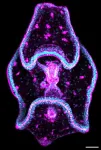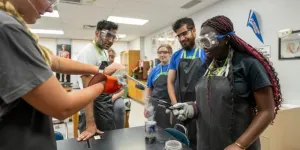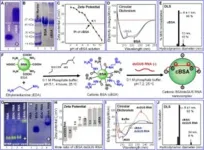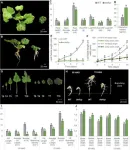(Press-News.org) By Devon McPhee
WOODS HOLE, Mass. -- Scientists have a handful of standard research organisms, including fruit flies and mice, that they use to study the evolutionary development (evo-devo) of animal lineages over time. Yet the more research organisms they can study, the deeper our understanding of life and the more knowledge we have to advance biomedicine and ecological conservation.
Researchers at the Marine Biological Laboratory (MBL), Woods Hole, and the Stazione Zoologica Anton Dohrn (SZS) in Naples, Italy, have added to the evo-devo toolbox by establishing Holothuria tubulosa, a species of sea cucumber, as an experimental research organism. They published their protocols recently in Frontiers in Evolutionary Developmental Biology.
The sea cucumber, found abundantly in the Mediterranean Sea and the eastern Atlantic Ocean, is an echinoderm, a group of marine invertebrates that includes sea urchins, sea stars and sand dollars. Some species of echinoderms have been used as developmental models for over a century thanks to their low costs, high fecundity, optically clear larvae and, more recently, amenability to genetic studies.
“Echinoderms are the closest invertebrates to humans genetically, which means we have most of our genes in common. If we understand how those genes function in an echinoderm, than we also know how they function in humans,” said Margherita Perillo, a research scientist at MBL who led the study.
“Sea cucumbers also have attributes and special skills — such as being deposit feeders, which cleans the ocean floor, and the ability to completely regenerate their whole body — that could be useful in conservation and biomedicine,” she said.
Protocol for producing embryonic cultures
The first step in establishing H. tubulosa as a research organism was to develop a protocol to efficiently produce embryonic cultures in a lab setting. Existing methods, including mimicking the animal’s natural breeding cycle and inducing the release of all the animal’s organs by evisceration (a behavior that sea cucumbers normally exhibit when threatened) were complicated, inefficient or both.
To overcome this, the team led by Rossella Annunziata (SZS) and Perillo pioneered a noninvasive technique to repeatedly harvest a small number of gametes (sperm and eggs) over a long period of time. The microsurgery involves a small incision near a sea cucumber’s reproductive organs, allowing for the retrieval of testes or ovaries. The incision heals quickly and gives researchers the ability to harvest every few days from the same animal.
Since eggs retrieved using this technique have not reached maturation and cannot be fertilized, the researchers next expose the harvested ovaries to a synthetic peptide – Thioredoxin-2 peptide, known to work in another species – to make them receptive to sperm. They then grow the fertilized egg in a culture, where it reaches the metamorphosis stage in about eight weeks.
“Our protocol removes a major bottleneck that has kept H. tubulosa from being used as a research organism and opens the door for more scientists to use it,” Perillo said.
Building on a strong foundation
The team next used high-resolution microscopy coupled with immunohistochemistry to document the development of the larvae, with a focus on its unique structures. Their detailed description will serve as a foundation for future studies that aim to use genetic manipulations to functionally dissect development in H. tubulosa.
Additionally, they provided an example of how scientists can use echinoderm larvae to study the diversification of anatomical structures in closely related organisms. In this case, they used serotonin immunostaining to show how the location of serotonin neurons differed between types of echinoderms. Why and how this diversification occurs is an open question in evolutionary development biology.
Perillo received an Emerging Research Organisms grants from the Society of Developmental Biology to support her work and to continue her study of H. tubulosa.
“The sea cucumber is a fascinating animal and the better we understand it, the more value it has as a research organism,” said Perillo. “My plan now is to develop genetic tools to help further characterize it as an emerging comparison model in evo-devo. At the same time, this collaborative work laid the foundation to establish a new sea cucumber species here at the MBL”
END
Study adds new sea cucumber species to the research toolbox
2024-06-07
ELSE PRESS RELEASES FROM THIS DATE:
Advancing cancer tracking: DiFC detects rare cells noninvasively
2024-06-07
In the relentless fight against cancer, a new technology promises to shed light on how we track and understand the spread of this disease within the body. A research team from Northeastern University and Dartmouth College recently developed a remarkable tool called "diffuse in vivo flow cytometry" (DiFC), which allows for the noninvasive detection and counting of rare cancer cells circulating in the bloodstream.
Monitoring cancer spread in real time
In a recent publication in the Journal of Biomedical Optics (JBO), the research team detailed their innovative two-color DiFC system, capable of simultaneously detecting two distinct populations of cancer ...
nTIDE May 2024 Jobs Report: People with Disabilities Succeeding in Finding Jobs
2024-06-07
East Hanover, NJ – June 7, 2024 –May job numbers showed gains for people with disabilities, who continue to engage with the labor market at historic levels, according to today’s National Trends in Disability Employment – semi-monthly update (nTIDE), issued by Kessler Foundation and the University of New Hampshire’s Institute on Disability (UNH-IOD). Increases in both labor force participation and employment indicate that people with disabilities are not only striving to work but succeeding in finding jobs. ...
World's leading technology associations publish comprehensive curricular guidelines for computer science at the undergraduate level
2024-06-07
ACM, the Association for Computing Machinery, has joined with the IEEE Computer Society (IEEE-CS) and the Association for the Advancement of Artificial Intelligence (AAAI) to develop “Computer Science Curricula 2023” (CS2023). CS2023 provides a comprehensive guide outlining the knowledge and competencies students should attain for degrees in computer science and related disciplines at the undergraduate level.
Establishing uniform curricular guidelines for computer science disciplines is viewed as being essential to the ongoing vitality of the field and the future success of the students ...
Online professional education works for complex topics
2024-06-07
Online education is effective for teaching complicated topics like quantum information science (QIS) to high school science educators, according to a new paper by University of Texas at Arlington researchers published in The Physics Teacher.
“COVID-19 forced educators to adjust their educational best practices to an unfamiliar virtual classroom, and professional development was no different,” said Karen Jo Matsler, assistant professor in practice for UTeach at UTA and lead author on the study.
Ramon Lopez, professor of physics, was coprincipal investigator ...
Transforming agriculture: engineered nanoparticles for plant gene regulation
2024-06-07
In a major advancement for plant biology and agriculture, researchers have developed a novel method for systemic gene silencing in plants using engineered dsRNA-protein nanoparticles. This technique, which rapidly characterizes gene functions, could revolutionize in planta gene editing. The new approach addresses the longstanding challenge of transporting RNA molecules across plant cell membranes, providing a faster, non-transgenic solution for enhancing crop productivity.
Gene silencing in plants has faced significant challenges, primarily due to the difficulty of transporting RNA molecules across plant cell membranes and achieving systemic effects. Traditional genetic engineering ...
Understanding inequities in nurses’ moral distress during COVID-19
2024-06-07
Research has shown that, when nurses feel they are being prevented from taking a morally justifiable action or achieving an ethical outcome, it contributes to poor mental health, burnout, and intent to leave one’s job. Surveys from the COVID-19 pandemic found that a shortage of personal protective equipment (PPE) and lack of perceived support from hospital administrators were associated with higher levels of this moral distress.
University of Pennsylvania School of Nursing researchers and their collaborators hypothesized that nurses working in hospitals where Black patients predominantly access care—which they call Black-serving hospitals, or ...
Flavor unleashed: a scientific journey into the world of table grapes
2024-06-07
In a recent study, scientists have unlocked the secrets behind the diverse flavors of table grapes. By examining 38 different cultivars, the research offers unprecedented insights into the volatile compounds that shape our taste experiences, paving the way for enhanced grape quality and flavor.
The flavor of table grapes, influenced by various volatile compounds, plays a significant role in consumer preference and marketability. Traditional flavor analysis methods often fail to capture the complexity and diversity of grape flavors, especially in hybrid varieties. Conventional flavor classifications like muscat and foxy are insufficient for describing the wide range of flavors ...
Shrinking statures, growing insights: unraveling the genetic underpinnings of dwarfism in squash
2024-06-07
Unlocking the secrets of nature, a pioneering study has pinpointed a gene mutation with profound implications for plant height and stress tolerance. The discovery lies in the CpDWF5 gene, whose alteration leads to a compact squash plant with a unique resistance to salt stress, marking a leap forward in agricultural science.
In the quest to bolster crop yields and fortify plants against environmental stressors, the delicate interplay of phytohormones stands as a keystone. Yet, our grasp of these genetic levers, particularly those dictating plant stature and resilience to salinity, remains tenuous. Bridging ...
Fat molecule’s inability to bond with shape-shifting protein in cell’s powerhouse linked to an inherited metabolic disease
2024-06-07
FOR IMMEDIATE RELEASE
By studying mutations in yeast and human cells, Johns Hopkins Medicine scientists say they have found that biochemical bonds between fats and proteins in the mitochondrion, the cell’s powerhouse, play a crucial role in how our cells produce energy.
The study results, published June 5 in The EMBO Journal, shed new light, researchers say, on the way the altered mitochondrial membranes found in people with metabolic diseases such as Barth syndrome, a rare genetic disorder that weakens the heart, fail to enable cellular power production.
Metabolism is a set of biochemical reactions central to making energy to fuel life and to getting rid of substances a body no ...
Wildfire smoke reached 99% of U.S. lakes in 2019-2021
2024-06-07
Where there’s smoke, there’s not necessarily fire.
Wildfire smoke, sometimes drifting from hundreds of miles away, touched nearly every lake in North America for at least one day per year from 2019 to 2021, according to a study from the University of California, Davis.
Even more significantly, the study, published in the journal Global Change Biology, found that 89% of the lakes in North America experienced smoke for more than 30 days during each of those three years of intense wildfire activity.
“That was surprising, even ...










